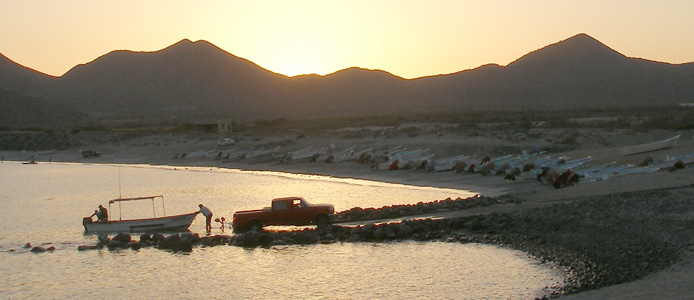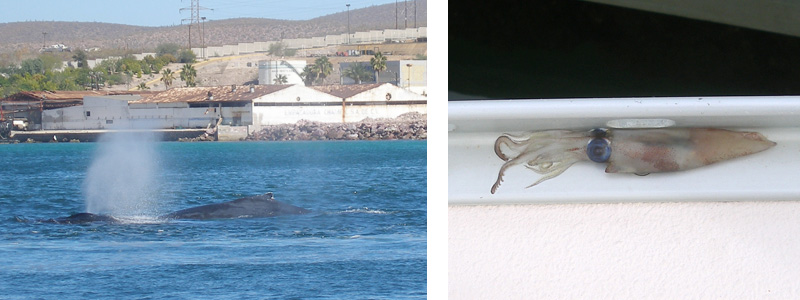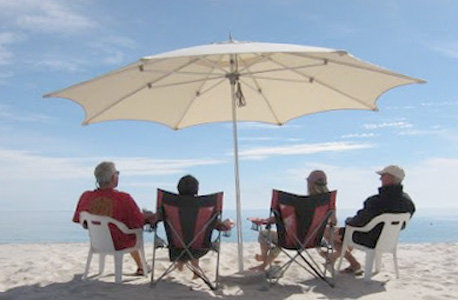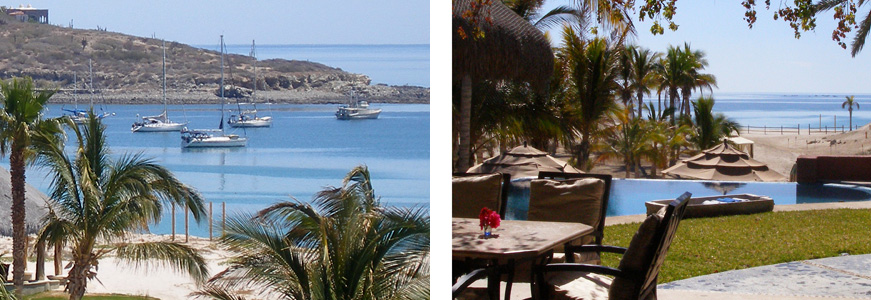(posted immediately following a nine day stay at Ensenada de Los Muertos – Bay of Dreams – on the southeast corner of the Baja peninsula)

Of all the sailboats cruising Pacific Mexico, probably the bulk of them move back and forth between various points along the Baja peninsula and the mainland between Thanksgiving and Easter. Typically the migration is first southeastward, as the winter weather can be nicer on the mainland. Once spring comes, the Baja side really shines and everyone goes (north) west again. Finishing our second winter down here, we have since completed our third and fourth transits of the Southern Sea of Cortez. A common (and shortest route) for the “southern crossing” (transiting the southern margin of the Sea of Cortez where it meets the Pacific ocean) is from Mazatlan to Los Frailes (also on the SE corner of Baja), which for us can be a 26-28 hour journey making good speed (about 145 miles at approximately 7 knots).
(If you have not yet done so, click here to visit our location page and you’ll see a small map of where we have been transiting).
The crossing itself can be a whole lot of nothing, just time passing by culminated with a celebration at the end to mark success (such as a restaurant meal ashore or cruisers beach party). There’s a great deal of emptiness on the ocean in between the dolphin and whale sightings, bird acrobatics and occasional hitchhiking, book/magazine reading, and stereo playing. Eat, drink (not THAT kind of drinking!), nap.

Today’s interview comes from Theresa (she introduced us! so she must get a good share of credit for this adventure we are on!)
When you are out at sea do you keep a watch at night?
These “southern crossings” that we’ve been doing take 24 hours or more with nowhere to stop along the way. Having no land to run into along the way makes things a bit easier as far as keeping a watch, but occasionally there are a few other boats to look out for! At night we tend to watch our radar screen just as much as we watch the ocean/sea around us. In the daytime we can generally see around us for at least several miles, so the radar is less important.
One of the instruments we added to the boat while still in California, was an AIS (similar to the transponders used in aircraft), this allows us to monitor the positions of commercial ships (up to 200 miles away, who are REQUIRED to install these devices), and we also put out an identifying signal that those ships can see.

On our latest (south) east to (north) west passage, from Isla Isabel to Muertos – 36 hours, 258 nautical miles – we only saw two boats in our vicinity during the crossing – a fishing boat at least three miles away, and another who closed to within one mile behind us. For last spring’s westbound crossing we were in a loose caravan of about 16 sailboats, although we didn’t see more than a few (we were one of the first boats to start out), until we reached the Ensenada de los Muertos anchorage.

When we only have one single overnight to endure, we generally both stay up on deck at night (one of us can snooze in the cockpit, but be available to the “watch keeper” if needed.). Traveling in the daylight one of us will occasionally go down below for a nap. We definitely catch up on our sleep on our first night “in port.”
What’s the weather like?
We do our best to gather as much forecast information as possible before making a crossing. Good conditions mean we can make a good speed averaging 6-7 knots (about 6.6 – 7.7 mph); very rough conditions could slow us down to 2-3 knots! If we’re close to commonly used departure point on land (i.e. civilization) we can usually pick up some info via the Internet and there are also SSB (long range marine radio) reports we can receive about twice a day. Although the predictions are reasonably accurate, they are not perfect (just like your TV weather guy or gal at home!). We also subscribe to a free service that transmits an email forecast to our SSB radio (with computer modem). We could also spend money to receive emailed reports with our satellite phone, but have not felt a need for it at this point. We also listen on the SSB for “vessels underway” who might be reporting along the track we plan to follow, they can describe real-time conditions.

We generally look for the smoothest water possible, and if there are some favorable winds of the right speed and direction we are able to sail. If we are itchin’ to make that crossing, we will gladly take a “smooth water/no wind” crossing and run the engine to get us across, at least we are fairly fuel efficient! A night with a good full or near full moon is also a bonus.
Our eastbound crossing this January had some winds to push us along under sail quite nicely; however the seas were quite “lumpy” with some 4-6 footers behind us that provided some uncomfortable motion, which made for a tiring ride. Our latest westbound crossing offered very little wind (except 15 knots “on our nose” for the last three hours), but we motored along thankfully in mostly flat water.
Can either of your sail the boat by yourselves?
What we love about the boat we have, is that it was definitely designed for “short-handed” (one or two person) sailing. All of the sailing controls are right inside the cockpit and easy to reach and operate, so that no one has to go out onto the deck (greater likelihood of injury or falling overboard in rough seas), to keep the boat moving. Handling the controls for motoring or sailing in calm to moderate conditions is very easy for either one of us. We prefer to never be in a rush to get anywhere, so that we can avoid traveling if the conditions are going to be unpleasant.

Do you have someone travel with you when you are sailing a long distance?
The only time we have done this recently was on the Baja Ha-Ha rally that brought us to Mexico in 2010. A friend from our yacht club traveled with us, it was definitely a good idea as we had two long (for us!) runs – of 55 hours and 37 hours. It’s really helpful to have a third (or fourth!) person to keep you refreshed with a little more sleep time. Because we are making (and preferring) shorter trips around Mexico, we have not had the need for additional “crew” but would definitely consider it for longer runs.
Quite a few of the boats that we’ve met down here have either made or are now in the process of making the “puddle jump” across the Pacific (most of them will arrive first to the Marquesas/French Polynesia). An average trip for a boat our size could be 17-21 days…some folks do it with just two aboard…we have no interest in sailing that direction (or duration), but probably four people would be the comfort level for us.

